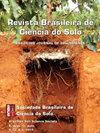Potassium buffering capacity and corrective potassium fertilizer recommendations in soils from Southern Brazil
IF 2
4区 农林科学
Q3 SOIL SCIENCE
引用次数: 0
Abstract
: Soils with low potassium (K) availability require corrective fertilization for grain crops. The recommended rate to increase K availability up to the critical level depends on the soil K buffering capacity (KBC). This study aimed to quantify the KBC and recalculate the rates necessary to reach the K critical level in 23 soils from Southern Brazil. Soil samples were incubated with six K rates, that were thus grouped according to CEC pH7.0 : below 7.5 cmol c dm -3 (0, 30, 60, 90, 120 and 180 kg K 2 O ha -1 ); from 7.6 to 15 cmol c dm -3 (0, 30, 60, 120, 180 and 240 kg K 2 O ha -1 ) and from 15.1 to 30 cmol c dm -3 (0, 30, 60, 120, 240 and 360 kg K 2 O ha -1 ). The soil test K (STK) was extracted by Mehlich-1 and the fertilizer rates necessary to increase the STK by 1 mg dm -3 were quantified. The KBC values were correlated with a suite of soil testing metrics. The relationship between the cation exchange capacity (CEC pH7.0 ) and KBC was modeled, and a linear-plateau equation presented the best fit. The K rates were calculated using the following equation: K rate = (Critical Level - STK) × KBC and were compared with the current rate indicated by the Local Soil Fertility Committee. The K fertilizer rates by KBC were about 2.5 times higher than the values currently indicated, and the largest differences were observed in soils with low STK and high CEC pH7.0 .巴西南部土壤的钾缓冲能力和校正钾肥建议
钾肥利用率低的土壤需要对粮食作物进行校正施肥。将钾有效度提高到临界水平的建议速率取决于土壤钾缓冲能力(KBC)。本研究旨在量化巴西南部23种土壤的KBC,并重新计算达到K临界水平所需的速率。土壤样品在6种K率下孵育,因此根据CEC pH7.0分组:低于7.5 cmol c dm -3(0,30, 60, 90, 120和180 kg k2o ha -1);从7.6至15 cmol cdm -3(0、30、60、120、180和240 kg k2o -1)和15.1至30 cmol cdm -3(0、30、60、120、240和360 kg k2o -1)。采用Mehlich-1提取土壤试验钾(STK),定量测定每增加1 mg dm -3所需的施肥量。KBC值与一套土壤测试指标相关。对阳离子交换容量(CEC pH7.0)与KBC之间的关系进行了建模,得到了最适合的线性平台方程。K率计算公式为:K率=(临界水平- STK) × KBC,并与当地土壤肥力委员会给出的现行K率进行比较。KBC施钾量约为目前所示值的2.5倍,在低STK和高CEC pH7.0土壤中差异最大。
本文章由计算机程序翻译,如有差异,请以英文原文为准。
求助全文
约1分钟内获得全文
求助全文
来源期刊

Revista Brasileira De Ciencia Do Solo
农林科学-土壤科学
CiteScore
3.00
自引率
11.80%
发文量
32
审稿时长
9-24 weeks
期刊介绍:
The Revista Brasileira de Ciência do Solo is a scientific journal published by the Brazilian Society for Soil Science (SBCS), founded in 1947, and is responsible for the propagation of original and inedited technical-scientific work of interest for Soil Science.
Contributions must not have been previously published or submit to other periodicals, with the only exception of articles presented in summarized form at professional meetings. Literature reviews are accepted when solicited by the Editorial Board.
 求助内容:
求助内容: 应助结果提醒方式:
应助结果提醒方式:


